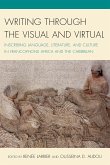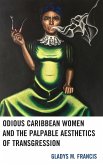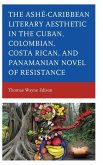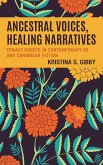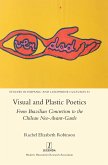Writing through the Visual and Virtual
Inscribing Language, Literature, and Culture in Francophone Africa and the Caribbean
Herausgeber: Larrier, Renée; Alidou, Ousseina
Writing through the Visual and Virtual
Inscribing Language, Literature, and Culture in Francophone Africa and the Caribbean
Herausgeber: Larrier, Renée; Alidou, Ousseina
- Gebundenes Buch
- Merkliste
- Auf die Merkliste
- Bewerten Bewerten
- Teilen
- Produkt teilen
- Produkterinnerung
- Produkterinnerung
Writing Through the Visual and Virtual:Inscribing Language, Literature, and Culture in Francophone Africa and the Caribbean explores the various cultures of writing in Francophone Africa and the Caribbean, and their relation to literature, orality, language, the visual arts, film, and popular culture. It is an invaluable resource to Francophone and cultural studies alike.
Andere Kunden interessierten sich auch für
![Writing through the Visual and Virtual Writing through the Visual and Virtual]() Writing through the Visual and Virtual65,99 €
Writing through the Visual and Virtual65,99 €![Odious Caribbean Women and the Palpable Aesthetics of Transgression Odious Caribbean Women and the Palpable Aesthetics of Transgression]() Gladys M. FrancisOdious Caribbean Women and the Palpable Aesthetics of Transgression115,99 €
Gladys M. FrancisOdious Caribbean Women and the Palpable Aesthetics of Transgression115,99 €![Ashé-Caribbean Literary Aesthetic in the Cuban, Colombian, Costa Rican, and Panamanian Novel of Resistance Ashé-Caribbean Literary Aesthetic in the Cuban, Colombian, Costa Rican, and Panamanian Novel of Resistance]() Thomas Wayne EdisonAshé-Caribbean Literary Aesthetic in the Cuban, Colombian, Costa Rican, and Panamanian Novel of Resistance136,99 €
Thomas Wayne EdisonAshé-Caribbean Literary Aesthetic in the Cuban, Colombian, Costa Rican, and Panamanian Novel of Resistance136,99 €![Ancestral Voices, Healing Narratives Ancestral Voices, Healing Narratives]() Kristina S. GibbyAncestral Voices, Healing Narratives84,99 €
Kristina S. GibbyAncestral Voices, Healing Narratives84,99 €![Visual and Plastic Poetics Visual and Plastic Poetics]() Rachel Elizabeth RobinsonVisual and Plastic Poetics100,99 €
Rachel Elizabeth RobinsonVisual and Plastic Poetics100,99 €![Memoirs of Toussaint and Isaac Louverture Memoirs of Toussaint and Isaac Louverture]() Arthur F. Saint-AubinMemoirs of Toussaint and Isaac Louverture113,99 €
Arthur F. Saint-AubinMemoirs of Toussaint and Isaac Louverture113,99 €![Visual and Plastic Poetics Visual and Plastic Poetics]() Rachel Elizabeth RobinsonVisual and Plastic Poetics18,99 €
Rachel Elizabeth RobinsonVisual and Plastic Poetics18,99 €-
-
-
Writing Through the Visual and Virtual:Inscribing Language, Literature, and Culture in Francophone Africa and the Caribbean explores the various cultures of writing in Francophone Africa and the Caribbean, and their relation to literature, orality, language, the visual arts, film, and popular culture. It is an invaluable resource to Francophone and cultural studies alike.
Produktdetails
- Produktdetails
- Verlag: Lexington Books
- Seitenzahl: 426
- Erscheinungstermin: 12. November 2015
- Englisch
- Abmessung: 235mm x 157mm x 27mm
- Gewicht: 764g
- ISBN-13: 9781498501637
- ISBN-10: 149850163X
- Artikelnr.: 43170914
- Herstellerkennzeichnung
- Libri GmbH
- Europaallee 1
- 36244 Bad Hersfeld
- gpsr@libri.de
- Verlag: Lexington Books
- Seitenzahl: 426
- Erscheinungstermin: 12. November 2015
- Englisch
- Abmessung: 235mm x 157mm x 27mm
- Gewicht: 764g
- ISBN-13: 9781498501637
- ISBN-10: 149850163X
- Artikelnr.: 43170914
- Herstellerkennzeichnung
- Libri GmbH
- Europaallee 1
- 36244 Bad Hersfeld
- gpsr@libri.de
Renée Larrier is professor and chair of the Department of French at Rutgers University New Brunswick. Ousseina D. Alidou is professor in the Department of African, Middle Eastern, and South Asian Languages and Literatures at Rutgers University New Brunswick.
Introduction:Traditions of Literacy by Renée Larrier andOusseina D. Alidou
Part I: Visual and Verbal Artistry: Texts and Text[iles] as Epistemology
Chapter 1: Embodying African Women's Epistemology: International Women's
Day Pagnes in Cameroon; Bertrade Ngo-Ngijol Banoum and Anne Patricia Rice
Chapter 2: Reading the Téra-tera: Textiles, Transportation, and Nationalism
in Niger's First Republic; Amanda Gilvin
Chapter 3: Becoming Griot: Righting Within a Minor Literature; Oumar
Diogoye Diouf
Chapter 4: Research on Droughts and Famines in the Sahel: the Contribution
of Oral Literature; Boureima Alpha Gado
Part II: Body Language/Writing [on] the Body
Chapter 5: Transgressive Embodied Writings of KAribbean Bodies in Pain;
Gladys Francis
Chapter 6: Alhaji Roaming the City: Gender, HIV-AIDS and the Performing
Arts; Ousseina D. Alidou
Chapter 7: Writing on the Visual: Lalla Essaydi's Photographic Tableaux;
Donna Gustafson
Chapter 8: Angles of Representation: Photography and the Vision of al
Misriyya [the Egyptian] in Women's Press of the Early Twentieth Century;
Fakhri Haghani
Part III: Inscribing Popular Culture
Chapter 9: Representing Adolescent Sexuality in the Sahel; Barbara Cooper
Chapter 10: There's More Than One Way to Make a Ceebu-Jën: Narrating West
African Recipes in Texts; Julie Huntington
Chapter 11: Reclamation of the Arena: Traditional Wrestling in West Africa;
Bojana Coulibaly
Chapter 12: Ritual Celebrations: Context of the Development of New African
Hybrid Cultures; Jean-Baptiste Sourou
Chapter 13: Simmering Exile; Edwidge Sylvestre-Ceide
Part IV: Language, Literacy, and Education
Chapter 14: Writing,Learning and Teaching Material for Early Childhood
Cultures: from Africa to a Global Context; Rokhaya Fall Diawara
Chapter 15: Orthographic Diversity in a World of Standards: Graphic
Representations of Vernacular Arabics in Morocco; Becky Schulthies
Chapter 16: The Polyphonous Classroom: Discourse on Language-in-Education
on Reunion Island; Meghan Tinsley
Chapter 17: Thundering Poetics/Murmuring Poetics: Doing Things With Words
as a Marker of Identity; Laurence Jay-Rayon
Part V: Intersections of Text and Image
Chapter 18: Wilson Bigaud's "Les Noces de Cana" [The Wedding at Cana]or the
Meeting of Colonial Heritage and Ancestral Traditions in Haitian Naive Art;
Jean Hérald Legagneur
Chapter 19: Tourist Art: A Tracery of the Visual/Virtual;Gabrielle Civil.
Images by Vladimir Cybil Charlier
Chapter 20: Religious Iconography in the Daily Life of the Senegalese;
Abdoulaye Elimane Kane
Chapter21:West African Culture in Animation: the Example of "Kirikou"; Maha
Gad El Hak
Part VI: Literature, Gender, and Identity
Chapter 22: Power and Patriarchy: Sexual Violence and Sexual Exploitation
in the Francophone and Hispanophone Caribbean Represented in Marie
Vieux-Chauvet's Amour, colère et folie, Simone Schwarz-Bart's Pluie et vent
sur Télumée Miracle, Rosario Ferré's "La Bella Durmiente," and Nelly
Rosario's El canto del agua;Phuong Hoang
Chapter 23: La Mulâtresse During the Two World Wars: Race, Gender, and
Sexuality in Suzanne Lacascade's Claire-Solange, âme-africaine and Mayotte
Capécia's Je suis Martiniquaise; Nathan H. Dize
Chapter 24: Inscriptions of Nature from Guadeloupe, Haiti, and Martinique;
Anne Rehill
Chapter 25: The Politics of Writing As a Space to Shape Identity(ies);
Khady Diène
Part I: Visual and Verbal Artistry: Texts and Text[iles] as Epistemology
Chapter 1: Embodying African Women's Epistemology: International Women's
Day Pagnes in Cameroon; Bertrade Ngo-Ngijol Banoum and Anne Patricia Rice
Chapter 2: Reading the Téra-tera: Textiles, Transportation, and Nationalism
in Niger's First Republic; Amanda Gilvin
Chapter 3: Becoming Griot: Righting Within a Minor Literature; Oumar
Diogoye Diouf
Chapter 4: Research on Droughts and Famines in the Sahel: the Contribution
of Oral Literature; Boureima Alpha Gado
Part II: Body Language/Writing [on] the Body
Chapter 5: Transgressive Embodied Writings of KAribbean Bodies in Pain;
Gladys Francis
Chapter 6: Alhaji Roaming the City: Gender, HIV-AIDS and the Performing
Arts; Ousseina D. Alidou
Chapter 7: Writing on the Visual: Lalla Essaydi's Photographic Tableaux;
Donna Gustafson
Chapter 8: Angles of Representation: Photography and the Vision of al
Misriyya [the Egyptian] in Women's Press of the Early Twentieth Century;
Fakhri Haghani
Part III: Inscribing Popular Culture
Chapter 9: Representing Adolescent Sexuality in the Sahel; Barbara Cooper
Chapter 10: There's More Than One Way to Make a Ceebu-Jën: Narrating West
African Recipes in Texts; Julie Huntington
Chapter 11: Reclamation of the Arena: Traditional Wrestling in West Africa;
Bojana Coulibaly
Chapter 12: Ritual Celebrations: Context of the Development of New African
Hybrid Cultures; Jean-Baptiste Sourou
Chapter 13: Simmering Exile; Edwidge Sylvestre-Ceide
Part IV: Language, Literacy, and Education
Chapter 14: Writing,Learning and Teaching Material for Early Childhood
Cultures: from Africa to a Global Context; Rokhaya Fall Diawara
Chapter 15: Orthographic Diversity in a World of Standards: Graphic
Representations of Vernacular Arabics in Morocco; Becky Schulthies
Chapter 16: The Polyphonous Classroom: Discourse on Language-in-Education
on Reunion Island; Meghan Tinsley
Chapter 17: Thundering Poetics/Murmuring Poetics: Doing Things With Words
as a Marker of Identity; Laurence Jay-Rayon
Part V: Intersections of Text and Image
Chapter 18: Wilson Bigaud's "Les Noces de Cana" [The Wedding at Cana]or the
Meeting of Colonial Heritage and Ancestral Traditions in Haitian Naive Art;
Jean Hérald Legagneur
Chapter 19: Tourist Art: A Tracery of the Visual/Virtual;Gabrielle Civil.
Images by Vladimir Cybil Charlier
Chapter 20: Religious Iconography in the Daily Life of the Senegalese;
Abdoulaye Elimane Kane
Chapter21:West African Culture in Animation: the Example of "Kirikou"; Maha
Gad El Hak
Part VI: Literature, Gender, and Identity
Chapter 22: Power and Patriarchy: Sexual Violence and Sexual Exploitation
in the Francophone and Hispanophone Caribbean Represented in Marie
Vieux-Chauvet's Amour, colère et folie, Simone Schwarz-Bart's Pluie et vent
sur Télumée Miracle, Rosario Ferré's "La Bella Durmiente," and Nelly
Rosario's El canto del agua;Phuong Hoang
Chapter 23: La Mulâtresse During the Two World Wars: Race, Gender, and
Sexuality in Suzanne Lacascade's Claire-Solange, âme-africaine and Mayotte
Capécia's Je suis Martiniquaise; Nathan H. Dize
Chapter 24: Inscriptions of Nature from Guadeloupe, Haiti, and Martinique;
Anne Rehill
Chapter 25: The Politics of Writing As a Space to Shape Identity(ies);
Khady Diène
Introduction:Traditions of Literacy by Renée Larrier andOusseina D. Alidou
Part I: Visual and Verbal Artistry: Texts and Text[iles] as Epistemology
Chapter 1: Embodying African Women's Epistemology: International Women's
Day Pagnes in Cameroon; Bertrade Ngo-Ngijol Banoum and Anne Patricia Rice
Chapter 2: Reading the Téra-tera: Textiles, Transportation, and Nationalism
in Niger's First Republic; Amanda Gilvin
Chapter 3: Becoming Griot: Righting Within a Minor Literature; Oumar
Diogoye Diouf
Chapter 4: Research on Droughts and Famines in the Sahel: the Contribution
of Oral Literature; Boureima Alpha Gado
Part II: Body Language/Writing [on] the Body
Chapter 5: Transgressive Embodied Writings of KAribbean Bodies in Pain;
Gladys Francis
Chapter 6: Alhaji Roaming the City: Gender, HIV-AIDS and the Performing
Arts; Ousseina D. Alidou
Chapter 7: Writing on the Visual: Lalla Essaydi's Photographic Tableaux;
Donna Gustafson
Chapter 8: Angles of Representation: Photography and the Vision of al
Misriyya [the Egyptian] in Women's Press of the Early Twentieth Century;
Fakhri Haghani
Part III: Inscribing Popular Culture
Chapter 9: Representing Adolescent Sexuality in the Sahel; Barbara Cooper
Chapter 10: There's More Than One Way to Make a Ceebu-Jën: Narrating West
African Recipes in Texts; Julie Huntington
Chapter 11: Reclamation of the Arena: Traditional Wrestling in West Africa;
Bojana Coulibaly
Chapter 12: Ritual Celebrations: Context of the Development of New African
Hybrid Cultures; Jean-Baptiste Sourou
Chapter 13: Simmering Exile; Edwidge Sylvestre-Ceide
Part IV: Language, Literacy, and Education
Chapter 14: Writing,Learning and Teaching Material for Early Childhood
Cultures: from Africa to a Global Context; Rokhaya Fall Diawara
Chapter 15: Orthographic Diversity in a World of Standards: Graphic
Representations of Vernacular Arabics in Morocco; Becky Schulthies
Chapter 16: The Polyphonous Classroom: Discourse on Language-in-Education
on Reunion Island; Meghan Tinsley
Chapter 17: Thundering Poetics/Murmuring Poetics: Doing Things With Words
as a Marker of Identity; Laurence Jay-Rayon
Part V: Intersections of Text and Image
Chapter 18: Wilson Bigaud's "Les Noces de Cana" [The Wedding at Cana]or the
Meeting of Colonial Heritage and Ancestral Traditions in Haitian Naive Art;
Jean Hérald Legagneur
Chapter 19: Tourist Art: A Tracery of the Visual/Virtual;Gabrielle Civil.
Images by Vladimir Cybil Charlier
Chapter 20: Religious Iconography in the Daily Life of the Senegalese;
Abdoulaye Elimane Kane
Chapter21:West African Culture in Animation: the Example of "Kirikou"; Maha
Gad El Hak
Part VI: Literature, Gender, and Identity
Chapter 22: Power and Patriarchy: Sexual Violence and Sexual Exploitation
in the Francophone and Hispanophone Caribbean Represented in Marie
Vieux-Chauvet's Amour, colère et folie, Simone Schwarz-Bart's Pluie et vent
sur Télumée Miracle, Rosario Ferré's "La Bella Durmiente," and Nelly
Rosario's El canto del agua;Phuong Hoang
Chapter 23: La Mulâtresse During the Two World Wars: Race, Gender, and
Sexuality in Suzanne Lacascade's Claire-Solange, âme-africaine and Mayotte
Capécia's Je suis Martiniquaise; Nathan H. Dize
Chapter 24: Inscriptions of Nature from Guadeloupe, Haiti, and Martinique;
Anne Rehill
Chapter 25: The Politics of Writing As a Space to Shape Identity(ies);
Khady Diène
Part I: Visual and Verbal Artistry: Texts and Text[iles] as Epistemology
Chapter 1: Embodying African Women's Epistemology: International Women's
Day Pagnes in Cameroon; Bertrade Ngo-Ngijol Banoum and Anne Patricia Rice
Chapter 2: Reading the Téra-tera: Textiles, Transportation, and Nationalism
in Niger's First Republic; Amanda Gilvin
Chapter 3: Becoming Griot: Righting Within a Minor Literature; Oumar
Diogoye Diouf
Chapter 4: Research on Droughts and Famines in the Sahel: the Contribution
of Oral Literature; Boureima Alpha Gado
Part II: Body Language/Writing [on] the Body
Chapter 5: Transgressive Embodied Writings of KAribbean Bodies in Pain;
Gladys Francis
Chapter 6: Alhaji Roaming the City: Gender, HIV-AIDS and the Performing
Arts; Ousseina D. Alidou
Chapter 7: Writing on the Visual: Lalla Essaydi's Photographic Tableaux;
Donna Gustafson
Chapter 8: Angles of Representation: Photography and the Vision of al
Misriyya [the Egyptian] in Women's Press of the Early Twentieth Century;
Fakhri Haghani
Part III: Inscribing Popular Culture
Chapter 9: Representing Adolescent Sexuality in the Sahel; Barbara Cooper
Chapter 10: There's More Than One Way to Make a Ceebu-Jën: Narrating West
African Recipes in Texts; Julie Huntington
Chapter 11: Reclamation of the Arena: Traditional Wrestling in West Africa;
Bojana Coulibaly
Chapter 12: Ritual Celebrations: Context of the Development of New African
Hybrid Cultures; Jean-Baptiste Sourou
Chapter 13: Simmering Exile; Edwidge Sylvestre-Ceide
Part IV: Language, Literacy, and Education
Chapter 14: Writing,Learning and Teaching Material for Early Childhood
Cultures: from Africa to a Global Context; Rokhaya Fall Diawara
Chapter 15: Orthographic Diversity in a World of Standards: Graphic
Representations of Vernacular Arabics in Morocco; Becky Schulthies
Chapter 16: The Polyphonous Classroom: Discourse on Language-in-Education
on Reunion Island; Meghan Tinsley
Chapter 17: Thundering Poetics/Murmuring Poetics: Doing Things With Words
as a Marker of Identity; Laurence Jay-Rayon
Part V: Intersections of Text and Image
Chapter 18: Wilson Bigaud's "Les Noces de Cana" [The Wedding at Cana]or the
Meeting of Colonial Heritage and Ancestral Traditions in Haitian Naive Art;
Jean Hérald Legagneur
Chapter 19: Tourist Art: A Tracery of the Visual/Virtual;Gabrielle Civil.
Images by Vladimir Cybil Charlier
Chapter 20: Religious Iconography in the Daily Life of the Senegalese;
Abdoulaye Elimane Kane
Chapter21:West African Culture in Animation: the Example of "Kirikou"; Maha
Gad El Hak
Part VI: Literature, Gender, and Identity
Chapter 22: Power and Patriarchy: Sexual Violence and Sexual Exploitation
in the Francophone and Hispanophone Caribbean Represented in Marie
Vieux-Chauvet's Amour, colère et folie, Simone Schwarz-Bart's Pluie et vent
sur Télumée Miracle, Rosario Ferré's "La Bella Durmiente," and Nelly
Rosario's El canto del agua;Phuong Hoang
Chapter 23: La Mulâtresse During the Two World Wars: Race, Gender, and
Sexuality in Suzanne Lacascade's Claire-Solange, âme-africaine and Mayotte
Capécia's Je suis Martiniquaise; Nathan H. Dize
Chapter 24: Inscriptions of Nature from Guadeloupe, Haiti, and Martinique;
Anne Rehill
Chapter 25: The Politics of Writing As a Space to Shape Identity(ies);
Khady Diène


